What you need to know about
COVID-19 | Click here

What you need to know about
COVID-19 | Click here


Thursday September 29, 2022 13:14
As a safe place to work, New Zealand compares poorly with other developed countries like Australia, UK and Canada. At a national level we are overrepresented in terms of health and safety statistics throughout the world.
In the last 7 years, 70 people on average have died as a result of a work-related accident. Serious illnesses and notifiable injuries are also excessively high on a per capita basis to comparable nations.
Top 5 most common workplace injuries in NZ.
In the aftermath of the Pike River mine explosion that killed 29 men in 2010, serious failings in New Zealand's health and safety record were revealed.
Recently released figures about the construction industry are an example, with two deaths a month on average and a serious injury every day.
WorkSafe, the agency dedicated to safety was created in 2013 but nine years on, our record still requires significant improvement.
In 2016 the Health and Safety At Work Act – 2015 came into force and for the first time provided enforcement powers to the Regulator – WorkSafe.
WorkSafe has a tough job as the watchdog of over 550,000 businesses/ organisations throughout New Zealand but the health and safety statistics are getting worse in some areas and that is not a good sign.
WorkSafe has 269 people authorised under the Health and Safety at Work to do enforcement, 174 of whom are actively doing inspections. The rest are managers and staff working on other harm prevention and engagement work.
The health and safety watchdog is now appealing for companies to do better.
WorkSafe chief executive Phil Parkes has taken the rare step of going public with the plea that significant change is required within New Zealand industry for us to reduce fatalities and serious injuries in the workplace.
Resourcing:
Our observation is that WorkSafe has primally focused on 3 areas for improvement:
This has produced a wealth of guidance material on how to improve H&S in the workplace that has been reinforced with workshops, roadshows around the country, hazardous substances guides and advertising/marketing of the safety message to New Zealand industry.
To be fair this has led to a huge improvement in engagement with health and safety, yet we are still a long way from achieving the Government target of reducing work accidents by 25%.
Furthermore, investigations into accidents which provides essential information on why work accidents occur, have also been dropping as WorkSafe struggles to deal with complex cases such as the eruption on Whakarri/White Island and more recently harassment and mental health in the workplace.
This then begs the question “Does WorkSafe have sufficient people and resources to effectively regulate New Zealand industry? Their funding has steadily increased but perhaps much more is required?
This is a critical issue for WorkSafe and the Government to work out; In the interim, we can envisage a significant move to more focussed workplace inspections, more scrutiny and rapid enforcement of known harm related issues/situations.
Already, we are seeing the Regulator addressing two particular areas of harm when on routine inspections and they almost always issue a “Improvement Notice” requiring the following:
If you have any concerns around this topic or other H&S matters, your Securo Consultant is available to help and assist you, so please give them a call or alternatively, you can contact Securo head office on 0800 55 33 44.